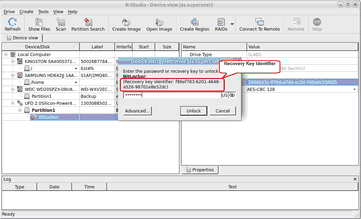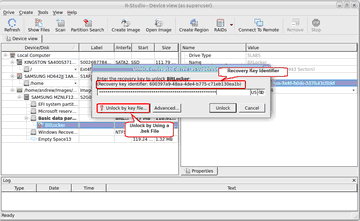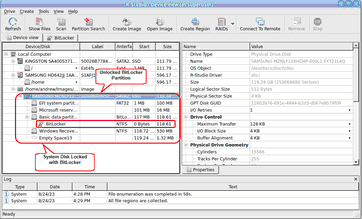- Contents
- Index
- A -
Apple CoreStorage/FileVault/Fusion Drive Volumes
- B -
Bad Sectors settings
Set default read retries count for all drives
Binary (byte to byte copy)
BitLocker System Drive Encryption
Broken File Name
Rename and change all invalid symbols to:
Broken File Name options
Button
Buttons
Create virtual volume sets or RAIDs
- C -
Connect to R-Studio settings
Contact information and technical support
Find Previous Versions of the File
Find Template Signature Previous
Remove All Scanned Information
Contextt menu
Create menu
Creating and saving your own RAID configuration
Creating Startup Disks for Mac and Linux Computers
- D -
Data Copy in Text/hexadecimal editor
Data Recovery on HFS/HFS+ File System
Description Files for Various RAID Configurations
Devices to Store Recovered Files
Dialog box
Dialog boxes
Edit Block RAID Layout Presets
Please configure R-Studio Agent for Mac
Please configure R-Studio Agent for Windows
R-Studio Agent for Linux Configuration
There is not enough space on the disk
Drive menu
- E -
Edit menu
Find Template Signature Previous
Editor tabs
Exclusive Region options
- F -
Fast Search for Lost Partitions
File Already Exists
File Information (R-Studio Technician/T80+)
File mask options
File menu
File Systems settings
Default encoding for Ext2/Ext3/Ext4/UFS volumes
Default encoding for HFS volumes
File Type Signature Specification
File Types
Find options
Find/Mark options
Find/mark objects only in real paths, ignore links to folders
Finding Previous File Versions
Forensic Data Collection Audit Log
- H -
Hidden Attribute
- I -
Image options
Image type:
Byte to byte image to a physical disk
Compressed image (R-Drive Image compatible)
VMDK (VmWare Virtual Machine Disk)
- K -
Known File Types settings
- L -
Log settings
Maximum messages in the Event Log
- M -
Main settings
Reset all hidden notifications
Messages
Double-click a logical disk...
- N -
Nested and Non-Standard RAID Levels
- O -
Opening several disks/partitions in one tab
Opening Virtual Disks from the Files Panel
- P -
Panels
Panes
Properties tab
- Q -
- R -
Recover options
Condense successful restoration events:
Open local folder (folders) when done
Recover alternative data streams:
Recover real folders structure
Region options
Contact information and technical support
Installing R-Studio Agent Emergency Startup Media Creator
Starting a Computer with the R-Studio Agent Emergency Startup Disk
R-Studio Agent for Mac main panel
R-Studio Agent for Windows main panel
Contact Informaiton and Technical Support
Installing R-Studio Emergency Startup Media Creator
Properties and Text/Hexadecimal Viewer
Starting a Computer with the R-Studio Emergency Startup Disks
R-Studio Emergency Startup Media Creator
- S -
Scan options
Search options
Settings
Shortcut menu
Smart drive copy
Copy all partitions onto original places
Expand/Shrink partition to whole disk
Smart partition copy
Startup Media Troubleshooting Options
Symbolic Links
Don't show symbolic links by default (Technician version)
Recovery as it is (Technician version)
Show folder symbolic links as links to their targets, without target content (Technician version)
Symbolic links display settings
Symbolic links recovery options
Syntaxis of a Description File for RAID Configurations
- T -
Tabs
Technical Information and Troubleshooting
Tools menu
- U -
- V -
Various Disk and Volume Managers
View menu
Volume Sets, Stripe Sets, and Mirrors
- W -
Window
Working with RAID 6 Presets
Home > Data Recovery Using R-Studio for Linux > Volume Sets and RAIDs > Various Disk and Volume Managers > BitLocker Drive Encryption
BitLocker Drive Encryption
BitLocker Drive Encryption , or BitLocker , is a data protection feature introduced by Microsoft since Windows Vista. It implements some hard/software measures to encrypt either USB external flash drives or internal system SSD/HDD devices. You may read more about BitLocker Drive Encryption on the Microsoft site or Wikipedia .
There are following encryption methods (protectors in the Microsoft terms) that can be utilized in the BitLocker protection:
• A TPM/TPM+PIN chip
• A USB key (a flash drive containing a .bek file)
• A user's password (not to confuse with a user's logon password) / recovery key
These methods can be used either individually or as a combination thereof. If they are used as a combination, knowing the decryption information for only one method is enough to unlock the device.
R‑Studio can unlock devices encrypted with BitLocker provided that all the necessary information is known.
BitLocker ToGo
This is the method used to lock external removable devices. The password or a recovery key is necessary to know to unlock the device. A recovery key may be in the printed form or contained in a file. A name of such a file has the following pattern: BitLocker Recovery Key 600397A9-48AA-4DE4-B775-C71EB130EA1B.txt , where the last characters is the BitLocker volume identifier. That file contains the BitLocker volume identifier and a recovery key.
To unlock a BitLocker ToGo device,
| 1 | Locate the device and double-click the BitLocker partition. |
| 2 | Enter the password or recovery key and click the Unlock button. |
| > | R‑Studio will unlock the volume |
BitLocker System Drive Encryption
This is the method used to lock internal system drives.
Depending on what methods are used, the following information is necessary to know to unlock the drive.
• A recovery key in the printed form or in a file. A name of such a file has the following pattern: BitLocker Recovery Key FDA7B96C-635E-45AA-BE63-00C3DB3771EE.txt , where the last characters is the BitLocker volume identifier. That file contains the BitLocker volume identifier and a recovery key.
• A password used to start the preboot process. It shouldn't be confused with the password for the user's logon.
• An external USB flash drive containing its .bek file. Note that Windows sets System and Hidden attributes for such files and Windows doesn't show such files by default.
To unlock a system drive with a BitLocker partition ,
| 1 | Locate the device and double-click the BitLocker partition. |
| 2 | Enter the password or recovery key and click the Unlock button. |
If you have the .bec file, click the Unlock by key file button and load the file.
| > | R‑Studio will unlock the volume |
Only in registered R-Studio Technician/T80+ versions.
If only the TPM/TPM+PIN hardware was used to encrypt the partition, you must have either the FVEK (Full Volume Encryption Key) or VMK (Volume Master Key) data. Obtaining these keys is a very hard task, only quite advanced forensic professionals can do that using specialized hardware. Sometimes it may be possible to extract a FVEK from memory dumps and/or hibernation files, but this is still not a trivial process.
If you have FVEK or VMK data, click the Advanced button, select the key type of the data, enter the key or load a file with the key.
R‑Studio for Linux will unlock the volume.
You may also save and load encryption information from a BitLocker Encryption volume.
Home > Data Recovery Using R-Studio for Linux > Volume Sets and RAIDs > Various Disk and Volume Managers > BitLocker Drive Encryption
- R-Studio Technician: activation using a USB stick
- Data Recovery Guide
- Why R-Studio?
- R-Studio for Forensic and Data Recovery Business
- R-STUDIO Review on TopTenReviews
- File Recovery Specifics for SSD devices
- How to recover data from NVMe devices
- Predicting Success of Common Data Recovery Cases
- Recovery of Overwritten Data
- Emergency File Recovery Using R-Studio Emergency
- RAID Recovery Presentation
- R-Studio: Data recovery from a non-functional computer
- File Recovery from a Computer that Won't Boot
- Clone Disks Before File Recovery
- HD Video Recovery from SD cards
- File Recovery from an Unbootable Mac Computer
- The best way to recover files from a Mac system disk
- Data Recovery from an Encrypted Linux Disk after a System Crash
- Data Recovery from Apple Disk Images (.DMG files)
- File Recovery after Re-installing Windows
- R-Studio: Data Recovery over Network
- How To Use R-Studio Corporate Package
- Data Recovery from a Re-Formatted NTFS Disk
- Data Recovery from an ReFS disk
- Data Recovery from a Re-Formatted exFAT/FAT Disk
- Data Recovery from an Erased HFS Disk
- Data Recovery from an Erased APFS Disk
- Data Recovery from a Re-Formatted Ext2/3/4FS Disk
- Data Recovery from an XFS Disk
- Data Recovery from a Simple NAS
- How to connect virtual RAID and LVM/LDM volumes to the operating system
- Specifics of File Recovery After a Quick Format
- Data Recovery After Partition Manager Crash
- File Recovery vs. File Repair
- Data Recovery from Virtual Machines
- How to Connect Disks to a Computer
- Emergency Data Recovery over Network
- Data Recovery over the Internet
- Creating a Custom Known File Type for R-Studio
- Finding RAID parameters
- Recovering Partitions on a Damaged Disk
- NAT and Firewall Traversal for Remote Data Recovery
- Data Recovery from an External Disk with a Damaged File System
- File Recovery Basics
- Default Parameters of Software Stripe Sets (RAID 0) in Mac OS X
- Data Recovery from Virtual Hard Disk (VHD/VHDX) Files
- Data Recovery from Various File Container Formats and Encrypted Disks
- Automatic RAID Parameter Detection
- IntelligentScan Data Recovery Technology
- Multi-pass imaging in R-Studio
- Runtime Imaging in R-Studio
- Linear Imaging vs Runtime Imaging vs Multi-Pass Imaging
- USB Stabilizer Tech for unstable USB devices
- Joint work of R-Studio and PC-3000 UDMA hardware
- Joint work of R-Studio and HDDSuperClone
- R-Studio T80+ - A Professional Data Recovery and Forensic Solution for Small Business and Individuals Just for 1 USD/day
- Backup Articles
- R-Drive Image Standalone and Corporate license transferring
- Fixing Windows update error 0x80070643 with R-Drive Image
- Backup with Confidence
- R-Drive Image as a free powerful partition manager
- Computer Recovery and System Restore
- Disk Cloning and Mass System Deployment
- Accessing Individual Files or Folders on a Backed Up Disk Image
- R-Drive Image startup / bootable version
- File Backup for Personal Computers and Laptops of Home and Self-Employed Users
- Creating a Data Consistent, Space Efficient Data Backup Plan for a Small Business Server
- How to Move the Already Installed Windows from an Old HDD to a New SSD Device and Create a Hybrid Data Storage System
- How to Move an Installed Windows to a Larger Disk
- How to Move a BitLocker-Encrypted System Disk to a New Storage Device
- How to backup and restore disks on Linux and Mac computers using R-Drive Image
- Undelete Articles
- Get Deleted Files Back
- Free Recovery from SD and Memory cards
- R-Undelete: Video Recovery
- Recovery from an External Device with a Damaged File System
- File recovery from a non-functional computer
- Free File Recovery from an Android Phone Memory Card
- Free Photo and Video File Recovery Tutorial
- Easy file recovery in three steps








